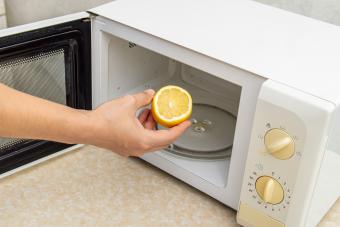
From pet scratches to mold, sometimes hardwood can feel like it’s more work than it’s worth. Don’t throw the towel in on your beautiful hardwood floors just yet. Salvage their natural shine by following these surefire methods for cleaning mold off your wood floors and keeping it gone for good.
Prep Your Floors for Mold Removal
Mold is one of those silent killers that creeps in so slowly that, by the time you realize it’s taken over, it’s often too late. Thankfully, your house’s fate isn’t as dismal as the horror movie connections make it seem. If you catch the mold outbreak in time, you can clean it up yourself.
Before you can even think about attacking the mold growing on your wood floors, you need to properly prepare the area and yourself.
Grab Some Safety Gear
Cleaning mold is no joke! Disturb mold spores even a little bit, and they’ll fly through the air and (potentially) into your body. Keep yourself from being exposed by putting on some safety gear.
- Gloves
- Goggles/glasses
- Hair covering
- Face mask
Remove Everything That You Can
Everything you can take out, you should. Sure, it’s an extra precaution, but you’d rather take an hour to move your jackets hanging over the dining room table chairs than deal with them being covered in mold in a few weeks.
Ventilate & Vacuum the Area
Whenever you’re working with chemicals, you want to ventilate the area. Open the windows if they’re in the room to give any flying mold a place to go.
Break out the vacuum (preferably ones with HEPA filters) and go over the mold spots. This will give you a head start on mold spore removal.
Turn off your central air if you’ve got it before cleaning. If you don’t, you might have mold circulating through your air long after you've finished cleaning.
Try One of These 3 Ways to Remove Mold From Hardwood Floors
You have options to remove the mold. Try one of these three methods.
Use a Vinegar & Water Solution
One method for cleaning hardwood is with an equal parts water and vinegar solution. Distilled white vinegar has great antimicrobial properties and can clean up mold spores in a jiffy. Simply spray the mixture on the moldy spots, let sit for an hour, and then wipe it up with a moistened microfiber cloth.
Anytime you use a liquid on your wood floors, go over it with a clean towel to make sure you get every last bit of moisture up. Leave any moisture behind, and you can perpetuate the mold cycle that you’re trying to end.
Use a Dishwashing Liquid & Water Solution
If you catch the mold really early, you should be able to clean it up with a dishwashing liquid and warm water mix. A teaspoon or two of your non-scented dishwashing liquid in a spray bottle of water should be enough.
Spray the moldy areas and scrub with a microfiber towel or sponge to fully release the mold from your floors. Wipe things down with some dry towels when you’re finished.
Some people like to set up fogging machines while they’re cleaning to trap the mold spores in the air. When weighed down by the water molecules, they’ll fall back to the ground where you can kill them.
Related: How to Clean Mold From Your Bathroom Ceilings Like a Pro
Try a Borax & Water Paste
If the mold is proving stubborn, try cleaning it with a boiling water and borax solution. Mix ½ cup of borax to every 2 quarts of water. It should end up being a little thinner than other cleaning pastes. Using a dishcloth or paintbrush, cover the affected areas with the mixture.

Let the borax dry, and then wipe it up with a wet microfiber cloth. Go over it with a dry one to clear up any moisture.
Figure Out What’s Causing the Mold
You’re not finished until you’ve figured out the source of the mold and mildew and done something about it. You might have a slow (but persistent) leak that needs to be patched up. Or maybe you’ve got a hole underneath your flooring that’s letting water in. Even poor ventilation in moist rooms (like bathrooms) can do a number on the hardwood.
The best way to keep mold from popping up in the future is to nip the problem in the bud.
Know When to Call a Professional
Just because you can do something yourself doesn’t always mean you should. If the molded areas are more than a couple of feet wide, you shouldn’t try to tackle it on your own. Similarly, if you have extremely severe mold, then you need to let the professionals handle it.
Of course, we understand that mold remediation isn't cheap. But not calling in the pros because you think it’ll be fine usually leads to completely gutting the floors and replacing them. So yes, if you’ve got more than a mild mold problem, you need to invest the money in mold remediation.
Sometimes, Your Wood Can’t Be Saved
It’s important to accept early on in mold cleaning that your hardwood might be beyond saving. With wood flooring, mold tends to grow from the underside up. So, by the time you notice it, it’s usually spread throughout the porous wood. Finding mold isn’t necessarily a death sentence to your flooring, but it can be.

Take Back Your Hardwood Floors
Mold happens to the best of us. Everyone will experience a persistent mold spot at some point in their adult lives. But if yours happens to be with your hardwood floors, try these methods for cleaning it up first. And don’t forget to call in a professional if all else fails.







